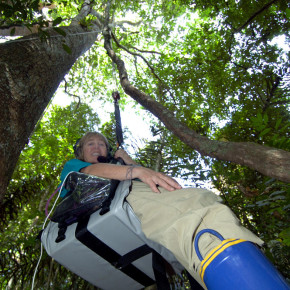Trees surrounding churches in Northern Ethiopia have been guarded for 1,500 years while the surrounding forests have been stripped bare. Shinto shrines protect ancient tree forests in Japan, the Buddha is said to have meditated for years beneath a bodhi tree, and the yew tree is believed to protect those who shelter beneath it.

What is it about trees that make them so revered?
I asked American scientist Meg Lowman. Affectionately named ‘Canopy Meg’, she conducts her research in the tops of trees -one of the most species-rich, highly threatened and least explored areas on Earth. Using special equipment and baskets that carry her as high as 200 feet above the ground, she has worked in five continents up in the tree tops among birds, sloughs, butterflies, reptiles, and the millions of insects these animals rely on for food.
“The canopy is the action spot of the tree,” says Meg. “Half the biodiversity of our land species live up there, yet we’ve only discovered about 10% of the canopy world.”
Trees are the building blocks of life on Earth, one of the most successful ‘machines’ that store carbon, and transform sunlight into energy and food for all the food chains on earth. Forests reduce human’s carbon footprint, preserve biodiversity, conserve water, reduce soil erosion, provide shade and natural medicine, house pollinators and provide homes for up to half of the species on our planet. They provide spiritual sanctuary. “Humans could not live if trees were not part of our environment,” Lowman says.
A mother of two grown boys, Meg Lowman compares trees to mothers, “they have a great deal in common.”
“Trees are the heart of productivity of many ecosystems, just as mothers function as the biological center of birth and life, trees provide sustenance for their entire community. They quietly drive important functions that make all life possible in the surrounding ecosystem.
If only I, as a mother, could have achieved as much as a tree,” Meg says with a smile.
Canopy Meg’s work comes with an unusual set of challenges: falling from 200 feet above the forest floor, being bitten by chiggers, and insects that carry infectious diseases — mosquitoes that transmit malaria and dengue fever, and the insect vectors of diseases such as river blindness. She points out that her African colleagues “are terrified of getting a tick bite in America that might give them Lyme disease, and they wonder how American scientists can work among grizzly bears and rattle snakes. We all have our anxieties about working in remote regions as field biologists,” she says.

So far, none of the perils of her job have stopped her.
“If we can better understand the complexities of biodiversity, then the chance of survival for all Earth’s life forms will certainly grow. So, for the sake of my kids, I will endure a few more chigger bites — and hopefully contribute a few threads of knowledge that will contribute to the sustainability of life on Earth.”
The other day, while hiking in the front country hills of Santa Barbara, I stopped to wrap my arms around a lone redwood tree. I wanted the tree to feel my immense appreciation for the amazing job this and all the other trees do to help keep the creatures on this earth, including us humans, alive. “Thank you,” I whispered to the tree, and squeezed tight.
For more about Meg Lowman, visit CanopyMeg.com
Books by Meg Lowman:
Beza, Who Saved Ethiopia’s Church Forests (great for teens)
Be the first to receive SavingWild’s interviews with the world’s top conservationists by signing up here:
6 Replies to ““Trees are Like Mothers,” says Meg Lowman”
Comments are closed.

I just wish I was younger to join her,
Always have been fascinated with any kind of forest….
Have lived in California and know,the big red wood trees……
Would love to live in a tree house….
Lived in the Austrian alps for 10 years……riding, skiing, cross country……wandering around all by myself….
Pinetrees with their great smell…especially after the rain…….
Moving to QUEENSLAND AUSTRALIA to live in the middle of eucalyptus trees and big bamboos……
And sugarcane fields……had it all…….and I am happy…..not enough time to do it all !!!!!!! Thank you….
Oh Helga it sounds like you are a like hearted soul with your love of nature. You comment is so wonderful I can see and feel and smell the pine forests too. Thank you.
You are doing an amazing job in educating people about importance of trees. Cutting trees in name of development is such a common problem, and more so in developing countries like mine. I hope the realisation dawns on people about importance of trees and they plant, nurture and leave them for our next generation.
i know Dr Margaret Lowman, i arrange her travels for the Ecoligical Society of America – she is passionate about what she does , she is truly ‘Canopy Meg’.
As usual, an enlightening piece by you, Lori.
joseph
what a small world. You have some wonderful clients Joseph. Thanks for sharing.
I subscribed the first time I saw your site. It would have been exciting to meet Jane Goodall and listen to her adventures. I’d love to be able to go on a mountain gorilla trek but I get a lot of info about them so it soothes my desire as doing all that walking isn’t something I can do anymore. Love those babies!! Too bad a lot of our human mothers can’t take lessons from the wild mothers. They could learn a lot on how to care for their children!!
Lois